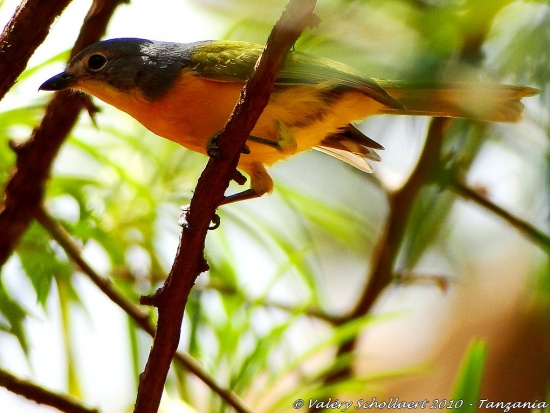Disambiguation: This name has also been used for Lühder's Bushshrike Laniarius luehderi
Alternative name: Sulphur-breasted Bushshrike1
- Chlorophoneus sulfureopectus
Telophorus sulfureopectus
Identification
Length 16-18 cm
Yellow forehead, eyebrow, throat and belly; orange breast.
Distribution
Sub-Saharan Africa
Western Africa: Senegambia, Senegal, The Gambia, Guinea-Bissau, Guinea, Mali, Sierra Leone, Liberia, Ivory Coast, Burkina Faso, Ghana, Togo, Benin, Nigeria, Niger, Chad, Cameroon, Central African Republic, Equatorial Guinea, DRC and Angola
Eastern Africa: Sudan, Ethiopia, Somalia, Kenya, Uganda, Rwanda, Burundi, Tanzania, Zambia, Mozambique and Malawi
Southern Africa: Namibia, Botswana, Zimbabwe, South Africa, KwaZulu-Natal and eSwatini
Taxonomy
Clements (2010)1 places this species in the genus Telophorus.
Subspecies[1]
There are two subspecies:
- C. s. sulfureopectus
- C. s. similis
- Southern Sudan, South Sudan, Ethiopia, southern Somalia, and eastern Democratic Republic of the Congo south to Angola, northern Namibia, and South Africa
An additional subspecies terminus is generally considered invalid5
Habitat
Savanna and woodland.
Behaviour
These birds are heard more often than seen, as they generally keep to the canopy; usually occur singly or in pairs.
Diet
They eat mainly arthropods gleaned from leaves, twigs and branches.
Breeding
Monogamous and territorial. The nest is an untidy cup built of twigs and other plant material by both sexes, between 2 and 10 m above the ground. One to three eggs are laid and incubated for 13-14 days by both sexes.
Vocalisation
The male calls year-round; voice is varied, but the most common call is a kew-tee-tee-tee-tee-tee whisle.
References
- Clements, J. F., T. S. Schulenberg, M. J. Iliff, D. Roberson, T. A. Fredericks, B. L. Sullivan, and C. L. Wood. 2017. The eBird/Clements checklist of birds of the world: v2017, with updates to August 2017. Downloaded from http://www.birds.cornell.edu/clementschecklist/download/
- Gill, F and M Wright. 2008. Birds of the World: Recommended English Names. Princeton University Press, Princeton NJ, USA. 2006. ISBN 9780691128276. Update (2008) downloaded from http://worldbirdnames.org/names.html.
- Hockey, PAR, WRJ Dean, and PG Ryan, eds. 2005. Roberts' Birds of Southern Africa. 7th ed. Cape Town: John Voelcker Bird Book Fund. ISBN 978-0620340533
- Sinclair, I and P Ryan. 2003. Birds of Africa South of the Sahara. Princeton: Princeton Univ. Press. ISBN 978-0691118154
- Avibase
Recommended Citation
- BirdForum Opus contributors. (2024) Orange-breasted Bushshrike. In: BirdForum, the forum for wild birds and birding. Retrieved 28 April 2024 from https://www.birdforum.net/opus/Orange-breasted_Bushshrike





